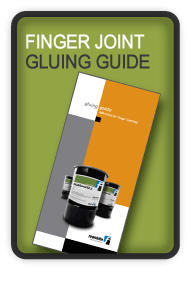Finger Joint
Franklin Adhesives & Polymers has a complete line of non-structural finger jointing adhesives, each designed for a particular end-use requirement. For instance, Woodbond 1910 meets ASTM D-5572 Dry Use requirements and is frequently used for interior applications such as furniture and trim moldings. If some water resistance is desired, Multibond 2000, a one-part cross-linking PVA, is a perfect choice. For exterior joints requiring ASTM D-5572 Wet Use performance, Advantage 405 and Advantage 160 are used by some of America's leading window and door manufacturers. If you are looking for the highest-performing finger joint glue on the market, consider Advantage 425. A highly water-resistant, two part cross-linking acetate emulsion adhesive, this product has a low minimum use temperature. It extrudes easily and has good finger coverage.
To determine an appropriate product option for your application, please refer to our product selector. The preparation of joints as well as the adhesive itself plays a critical role in the quality of finger jointed products. Most failures of finger jointed lumber are caused by poorly machined and poorly fitted dry joints. The adhesive is a factor in heat and water resistance. However, even the best adhesive available cannot make up for a poor fitting joint. The fit of the dry finger joint should be checked before gluing begins.
The following tips may help you achieve a properly fitting finger joint or trouble shoot problems in your operation guidelines.

Cutterheads
- Knife-set - are all knives measured? New knives and shims should be balanced and dialed in.
- Knife stack - be sure to check overall knife stack for accuracy. Keep cutterheads in pairs and properly cleaned.
- Cutterheads should be sharpened as a set. Knife set should cut only .010” to .030” of wood.
Knife grinding
- Knives should be sharpened after running approximately 30,000 board feet (wood species
could cause this to vary). - 0.003" to 0.004" should be ground off upon each sharpening. No more than 0.00005" of metal should be taken off on the final cut.
- The hook angle is important in the finger profile and knives should be fitted to templates after three to four grindings.
- The set-up post should be used for realignment.
- The head should be balanced every three to six grindings.
Cutting machine
- Make sure cutterhead spindle is set vertically with no wear or play in the bearings.
- Chain carrier lugs should be squared with the trim saws and cutterheads. These should be checked periodically.
- Make sure trim saws are set true.
- Check bed rails for wear on a regular basis.
- Check hold down pressure to provide sufficient pressure to prevent movement of stock while cutting the joint.
Joint assembly
- Pressure should be held constant until joint is cured.
- End pressure should be set to provide 150-200 psi pressure for non-structural joints and 350-400 psi for structural joints.
- Crowder wheels should be aligned to match fingers accurately.
Adhesive application
- Sufficient adhesive spread will provide a uniform coverage that should cover 1/2-2/3 the length of the finger on both sides in a thin continuous film. Make sure fingers aren't skipped and that the adhesive is applied to the whole joint, not just the tips of the fingers.
- Were adhesive ingredients properly mixed?
- Excess adhesive squeeze-out can cause arcing in a radio frequency tunnel. It also causes adhesive build-up and poor adhesive efficiency. Too much adhesive can cause a hydraulic effect in finger joint.
Additional information on assembly gluing can be found in the full version of our Finger Joint Gluing Guide, or by contacting our technical support team. For more information about gluing equipment, please refer to our resources link.
FINGER JOINT PRODUCTS:
Advantage 160 - highly water-resistant, exceeds ASTM D5572 performance and ideal for finger jointing, edge gluing, radio frequency applications and hot pressing
Advantage 425 - has been designed for finger jointing applications requiring excellent water resistance and high performance
Advantage FJ-1 - has the highest water-resistance of any one-component PVA, meets ASTM D-5572-95 (2012) Wet Use for finger joints, has a low minimum use temperature, and a shear thinning rheology making it compatible for finger jointing and extrusion applications
Multibond EZ-2 - designed for cold press applications including finger jointing, but can also be used for radio frequency, assembly and hot press gluing
Multibond FJ-3 - designed for finger jointing of interior stock, and applications requiring high heat resistance and easy extrusion
Multibond 2000 – produces a water resistant bond recommended for hot or cold press and assembly gluing applications
Woodbond 1910 - ideal for finger jointing of interior stock and has excellent handling properties, high heat resistance and easy extrusion capabilities